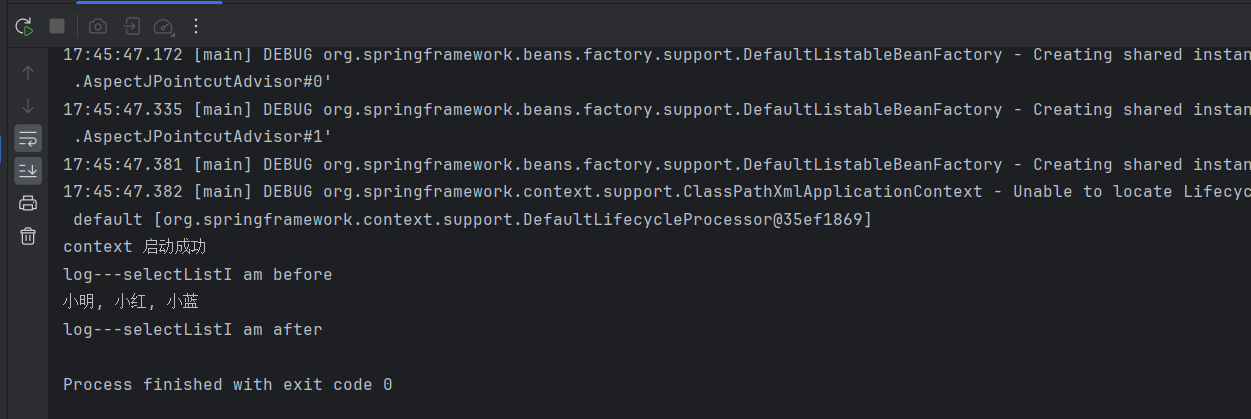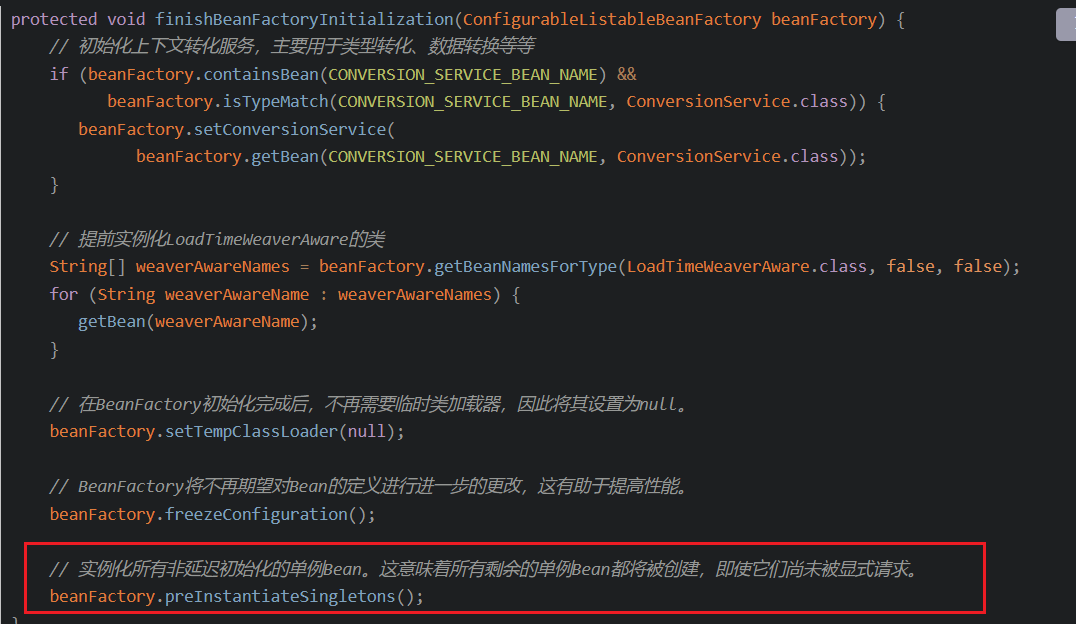文章目录
一、引言
AOP 是Spring框架的重点之一,AOP全称为Aspect-Oriented Programming,意思为面向切面编程,这种编程方式是一种编程的范式。
AOP允许开发者将横向关注点(如日志记录、事务管理等操作)与业务逻辑分开来,从而提高代码的模块化和可维护性。
下面从浅入深彻底搞懂Spring AOP的底层原理!
注意,本篇文章中使用的
Spring框架的版本是4.0.0.RELEASE,不同版本之间源码会有一点点不同,但是大体逻辑差不多。推荐阅读者需要对
动态代理以及Spring IOC源码有一定了解,如果不了解可以阅读以下文章<dependency> <groupId>org.springframework</groupId> <artifactId>spring-context</artifactId> <version>4.0.0.RELEASE</version> </dependency> <dependency> <groupId>org.springframework</groupId> <artifactId>spring-aspects</artifactId> <version>4.0.0.RELEASE</version> </dependency>
二、Spring AOP的使用
UserService接口的定义
public interface UserService {
String selectList();
}
UserService接口实现类
public class UserServiceImpl implements UserService {
@Override
public String selectList() {
System.out.println("小明, 小红, 小蓝");
return "小明, 小红, 小蓝";
}
}
AOP前置处理与后置处理
public class AOPUtil {
private void before(JoinPoint joinPoint) {
//获取方法签名
Signature signature = joinPoint.getSignature();
//获取参数信息
Object[] args = joinPoint.getArgs();
System.out.println("log---" + signature.getName() + "I am before");
}
private void after(JoinPoint joinPoint) {
//获取方法签名
Signature signature = joinPoint.getSignature();
//获取参数信息
Object[] args = joinPoint.getArgs();
System.out.println("log---" + signature.getName() + "I am after");
}
}
XML配置文件
<?xml version="1.0" encoding="UTF-8"?>
<beans xmlns="http://www.springframework.org/schema/beans"
xmlns:xsi="http://www.w3.org/2001/XMLSchema-instance"
xmlns:aop="http://www.springframework.org/schema/aop"
xsi:schemaLocation="http://www.springframework.org/schema/beans
http://www.springframework.org/schema/beans/spring-beans.xsd
http://www.springframework.org/schema/aop
http://www.springframework.org/schema/aop/spring-aop.xsd">
<bean id="messageService" class="spring.aop.UserServiceImpl"/>
<bean id="aopUtil" class="spring.aop.AOPUtil"/>
<aop:config>
<aop:aspect ref="aopUtil">
<aop:pointcut id="myPoint" expression="execution(* spring.aop.UserService.selectList(..))"/>
<aop:before method="before" pointcut-ref="myPoint"/>
<aop:after method="after" pointcut-ref="myPoint"/>
</aop:aspect>
</aop:config>
</beans>
测试类
public class AOPTest {
public static void main(String[] args) {
ApplicationContext context = new ClassPathXmlApplicationContext("application.xml");
System.out.println("context 启动成功");
UserService userService = context.getBean(UserService.class);
userService.selectList();
}
}

我们只需要编写好切面的逻辑即可,然后在xml配置文件配置后切面的方法的执行顺序即可实现在目标方法的前面或后面运行某个逻辑。
这当中到底发生了什么呢?这些切面方法是何时被调用呢?别急接着往下看!
三、Spring AOP的组件
在阅读Spring AOP源码之前,先来看看Spring AOP的几个组件,这里源码会采取点到为止的方式,并不深入讲解
Pointcut:定义切面的匹配点,主要是类和方法。比如上面例子的spring.aop.UserService.selectList(..)方法就是匹配点。Advice:定义切面的行为,即在匹配点执行的操作。也就是上面例子的aop:before和aop:afterAdvisor:将Pointcut和Advice组合成一个对象,也就是一个完整的切面。Aspect:使用注解或XML配置方式定义的切面,通常包含了多个Advisor
3.1 Pointcut源码
Pointcut是一个接口,提供了getClassFilter方法和getMethodMatcher方法,用于获取当前匹配的类和方法
public interface Pointcut {
/**
* 返回一个ClassFilter对象, 用于确定哪些类被匹配,返回的对象不能为null
*/
ClassFilter getClassFilter();
/**
* 返回一个MethodMatcher对象,用于确定哪些方法被匹配
*/
MethodMatcher getMethodMatcher();
/**
* Canonical Pointcut instance that always matches.
*/
Pointcut TRUE = TruePointcut.INSTANCE;
}
AspectJExpressionPointcut是Pointcut的实现,除了上面两个方法,还提供了matches方法,用于判断是否匹配。
public class AspectJExpressionPointcut extends AbstractExpressionPointcut implements ClassFilter, IntroductionAwareMethodMatcher, BeanFactoryAware {
// 类的匹配
public boolean matches(Class<?> targetClass) {}
// 方法的匹配
public boolean matches(Method method, Class<?> targetClass, boolean hasIntroductions) {}
}
3.2 Advice源码
Advice接口没有需要实现的方法,它是用于定义切面的行为的,比如方法前切入、方法后切入、环绕切入等等。
public interface Advice {
}
// 前置切入实现
public interface BeforeAdvice extends Advice {}
// 后置切入实现
public interface AfterAdvice extends Advice {}
3.3 Advisor源码
Advisor接口定义了getAdvice方法和isPerInstance方法
public interface Advisor {
/**
* 返回与该Advisor关联的Advice
*/
Advice getAdvice();
/**
* 返回这个Advice是否与特定的实例关联。
*/
boolean isPerInstance();
}
3.4 Aspect源码
Spring AOP并没有Aspect这个接口,但是Aspect通常指下面这个
<aop:aspect ref="aopUtil">
</aop:aspect>
四、Spring AOP源码刨析
阅读Spring AOP源码和阅读Spring IOC源码的步骤一样,都是从读取application.xml配置文件开始。
因为AOP的配置信息是写在XML配置文件的,所以肯定需要读取XML配置文件获取AOP相关的信息,那么我们就看看这其中都做了什么吧。
直接定位到org.springframework.beans.factory.xml.DefaultBeanDefinitionDocumentReader#parseBeanDefinitions这个方法,不了解的可以先看看【Spring成神之路】一次SpringIOC源码之旅,女朋友也成为了Spring大神!
protected void parseBeanDefinitions(Element root, BeanDefinitionParserDelegate delegate) {
if (delegate.isDefaultNamespace(root)) {
NodeList nl = root.getChildNodes();
for (int i = 0; i < nl.getLength(); i++) {
Node node = nl.item(i);
if (node instanceof Element) {
Element ele = (Element) node;
if (delegate.isDefaultNamespace(ele)) {
// 如果是bean 这些就走这个逻辑
parseDefaultElement(ele, delegate);
}
else {
// AOP走这个逻辑
delegate.parseCustomElement(ele);
}
}
}
}
else {
delegate.parseCustomElement(root);
}
}
既然知道parseCustomElement方法是处理aop标签的,那么我们就进去看看是怎么个事?
public BeanDefinition parseCustomElement(Element ele) {
return parseCustomElement(ele, null);
}
public BeanDefinition parseCustomElement(Element ele, @Nullable BeanDefinition containingBd) {
// 获取当前的命名空间
String namespaceUri = getNamespaceURI(ele);
if (namespaceUri == null) {
return null;
}
// 根据命名空间获取对应的处理器
NamespaceHandler handler = this.readerContext.getNamespaceHandlerResolver().resolve(namespaceUri);
if (handler == null) {
error("Unable to locate Spring NamespaceHandler for XML schema namespace [" + namespaceUri + "]", ele);
return null;
}
// 用处理器就行解析
return handler.parse(ele, new ParserContext(this.readerContext, this, containingBd));
}
parseCustomElement方法干三件事:
- 获取元素的命名空间
- 根据命名空间获取对应的处理器
- 调用处理器的
parse方法进行处理
继续DEBUG,定位到了org.springframework.beans.factory.xml.NamespaceHandlerSupport#parse方法
public BeanDefinition parse(Element element, ParserContext parserContext) {
// 获取适合解析当前元素的BeanDefinitionParser
BeanDefinitionParser parser = findParserForElement(element, parserContext);
// 进行解析并返回一个BeanDefinition
return (parser != null ? parser.parse(element, parserContext) : null);
}
private BeanDefinitionParser findParserForElement(Element element, ParserContext parserContext) {
// 获取元素的本地名称, 比如aop:config,本地名称就是config
String localName = parserContext.getDelegate().getLocalName(element);
// 获取该本地名称的解析器
BeanDefinitionParser parser = this.parsers.get(localName);
if (parser == null) {
parserContext.getReaderContext().fatal(
"Cannot locate BeanDefinitionParser for element [" + localName + "]", element);
}
return parser;
}
public BeanDefinition parse(Element element, ParserContext parserContext) {
CompositeComponentDefinition compositeDef =
new CompositeComponentDefinition(element.getTagName(), parserContext.extractSource(element));
parserContext.pushContainingComponent(compositeDef);
// 设置自动代理创建器,这是Spring AOP实现的核心
configureAutoProxyCreator(parserContext, element);
// 遍历当前标签下的标签不同的标签进行不同处理
List<Element> childElts = DomUtils.getChildElements(element);
for (Element elt: childElts) {
String localName = parserContext.getDelegate().getLocalName(elt);
if (POINTCUT.equals(localName)) {
parsePointcut(elt, parserContext);
}
else if (ADVISOR.equals(localName)) {
parseAdvisor(elt, parserContext);
}
else if (ASPECT.equals(localName)) {
parseAspect(elt, parserContext);
}
}
parserContext.popAndRegisterContainingComponent();
return null;
}
4.1 configureAutoProxyCreator源码解析
configureAutoProxyCreator方法是Spring IOC的核心,主要作用是确保 AspectJ 自动代理创建器被正确注册到 Spring 容器中!
private void configureAutoProxyCreator(ParserContext parserContext, Element element) {
AopNamespaceUtils.registerAspectJAutoProxyCreatorIfNecessary(parserContext, element);
}
public static void registerAspectJAutoProxyCreatorIfNecessary(
ParserContext parserContext, Element sourceElement) {
BeanDefinition beanDefinition = AopConfigUtils.registerAspectJAutoProxyCreatorIfNecessary(
parserContext.getRegistry(), parserContext.extractSource(sourceElement));
useClassProxyingIfNecessary(parserContext.getRegistry(), sourceElement);
registerComponentIfNecessary(beanDefinition, parserContext);
}
该方法的目的是往Spring IOC容器中注册一个AspectjAwareAdvisorAutoProxyCreator,其负责创建代理对象和实现切面编程。
4.2 parsePointcut源码解析
parsePointcut方法的主要作用是负责解析aop:pointcut标签
<aop:pointcut id="myPoint" expression="execution(* spring.aop.UserService.selectList(..))"/>
private AbstractBeanDefinition parsePointcut(Element pointcutElement, ParserContext parserContext) {
// 获得
String id = pointcutElement.getAttribute(ID);
// 获得切点表达式
String expression = pointcutElement.getAttribute(EXPRESSION);
// 定义切点存储
AbstractBeanDefinition pointcutDefinition = null;
try {
// 将当前解析的切点ID压入解析状态栈
this.parseState.push(new PointcutEntry(id));
// 根据切点表达式创建切点定义
pointcutDefinition = createPointcutDefinition(expression);
// 设置切点的来源
pointcutDefinition.setSource(parserContext.extractSource(pointcutElement));
// 切点的Bean名称
String pointcutBeanName = id;
if (StringUtils.hasText(pointcutBeanName)) {
// 如果设置了id, 将切点注册到spring ioc容器中
parserContext.getRegistry().registerBeanDefinition(pointcutBeanName, pointcutDefinition);
}
else {
// 否则也是注入进spring ioc容器中并设置别名
pointcutBeanName = parserContext.getReaderContext().registerWithGeneratedName(pointcutDefinition);
}
// 注册一个PointcutComponentDefinition组件
parserContext.registerComponent(
new PointcutComponentDefinition(pointcutBeanName, pointcutDefinition, expression));
}
finally {
// 从栈弹出
this.parseState.pop();
}
return pointcutDefinition;
}
4.3 parseAdvisor源码解析
parseAdvisor方法负责解析<advisor>标签
private void parseAdvisor(Element advisorElement, ParserContext parserContext) {
AbstractBeanDefinition advisorDef = createAdvisorBeanDefinition(advisorElement, parserContext);
String id = advisorElement.getAttribute(ID);
try {
this.parseState.push(new AdvisorEntry(id));
String advisorBeanName = id;
// 注册进容器
if (StringUtils.hasText(advisorBeanName)) {
parserContext.getRegistry().registerBeanDefinition(advisorBeanName, advisorDef);
}
else {
advisorBeanName = parserContext.getReaderContext().registerWithGeneratedName(advisorDef);
}
// 解析切点
Object pointcut = parsePointcutProperty(advisorElement, parserContext);
// 根据pointcut的类型,将其添加到advisorDef的属性值中,并注册相关的组件。
if (pointcut instanceof BeanDefinition) {
advisorDef.getPropertyValues().add(POINTCUT, pointcut);
parserContext.registerComponent(
new AdvisorComponentDefinition(advisorBeanName, advisorDef, (BeanDefinition) pointcut));
}
else if (pointcut instanceof String) {
advisorDef.getPropertyValues().add(POINTCUT, new RuntimeBeanReference((String) pointcut));
parserContext.registerComponent(
new AdvisorComponentDefinition(advisorBeanName, advisorDef));
}
}
finally {
this.parseState.pop();
}
}
4.4 parseAspect源码解析
parseAspect负责解析aspect标签
private void parseAspect(Element aspectElement, ParserContext parserContext) {
// 获取ID值
String aspectId = aspectElement.getAttribute(ID);
// 获取ref属性
String aspectName = aspectElement.getAttribute(REF);
try {
this.parseState.push(new AspectEntry(aspectId, aspectName));
List<BeanDefinition> beanDefinitions = new ArrayList<>();
List<BeanReference> beanReferences = new ArrayList<>();
// 获得当前节点下的所有<declare-parents>子元素
List<Element> declareParents = DomUtils.getChildElementsByTagName(aspectElement, DECLARE_PARENTS);
for (int i = METHOD_INDEX; i < declareParents.size(); i++) {
Element declareParentsElement = declareParents.get(i);
// 解析节点并注册进IOC容器中
beanDefinitions.add(parseDeclareParents(declareParentsElement, parserContext));
}
// 获取当前节点的子节点
NodeList nodeList = aspectElement.getChildNodes();
boolean adviceFoundAlready = false;
for (int i = 0; i < nodeList.getLength(); i++) {
Node node = nodeList.item(i);
// 是否是advice节点
if (isAdviceNode(node, parserContext)) {
// 是否是第一个advice节点
if (!adviceFoundAlready) {
adviceFoundAlready = true;
if (!StringUtils.hasText(aspectName)) {
parserContext.getReaderContext().error(
"<aspect> tag needs aspect bean reference via 'ref' attribute when declaring advices.",
aspectElement, this.parseState.snapshot());
return;
}
// 添加一个运行时bean引用到beanReferences
beanReferences.add(new RuntimeBeanReference(aspectName));
}
// 如果节点是advice,则调用parseAdvice方法解析它,并创建一个顾问(advisor)的bean定义。
AbstractBeanDefinition advisorDefinition = parseAdvice(
aspectName, i, aspectElement, (Element) node, parserContext, beanDefinitions, beanReferences);
beanDefinitions.add(advisorDefinition);
}
}
// 使用解析得到的信息创建一个切面组件定义
AspectComponentDefinition aspectComponentDefinition = createAspectComponentDefinition(
aspectElement, aspectId, beanDefinitions, beanReferences, parserContext);
// 将切面组件定义推入解析上下文。
parserContext.pushContainingComponent(aspectComponentDefinition);
// 获取所有<pointcut>子元素。
List<Element> pointcuts = DomUtils.getChildElementsByTagName(aspectElement, POINTCUT);
for (Element pointcutElement : pointcuts) {
// 解析切点
parsePointcut(pointcutElement, parserContext);
}
// 从解析上下文中弹出并注册包含的组件。
parserContext.popAndRegisterContainingComponent();
}
finally {
this.parseState.pop();
}
}
总得来说,就是解析标签,将标签的内容包装成BeanDefinition并注册进IOC容器。
前面说到Advice就是一个切面的行为,而parseAdvice方法就是负责解析这个切面行为的
private AbstractBeanDefinition parseAdvice(
String aspectName, int order, Element aspectElement, Element adviceElement, ParserContext parserContext,
List<BeanDefinition> beanDefinitions, List<BeanReference> beanReferences) {
try {
this.parseState.push(new AdviceEntry(parserContext.getDelegate().getLocalName(adviceElement)));
// 解析advice节点中的 method 属性,将其创建成一个 beanDefinition 对象
RootBeanDefinition methodDefinition = new RootBeanDefinition(MethodLocatingFactoryBean.class);
methodDefinition.getPropertyValues().add("targetBeanName", aspectName);
methodDefinition.getPropertyValues().add("methodName", adviceElement.getAttribute("method"));
methodDefinition.setSynthetic(true);
// 关联aspectName(对应的就是案例中的aopUtil),包装为 SimpleBeanFactoryAwareAspectInstanceFactory 对象
RootBeanDefinition aspectFactoryDef =
new RootBeanDefinition(SimpleBeanFactoryAwareAspectInstanceFactory.class);
aspectFactoryDef.getPropertyValues().add("aspectBeanName", aspectName);
aspectFactoryDef.setSynthetic(true);
// 解析切点并综合上面两个bean包装成AbstractAspectJAdvice
AbstractBeanDefinition adviceDef = createAdviceDefinition(
adviceElement, parserContext, aspectName, order, methodDefinition, aspectFactoryDef,
beanDefinitions, beanReferences);
// 最终包装成AspectJPointcutAdvisor
RootBeanDefinition advisorDefinition = new RootBeanDefinition(AspectJPointcutAdvisor.class);
advisorDefinition.setSource(parserContext.extractSource(adviceElement));
advisorDefinition.getConstructorArgumentValues().addGenericArgumentValue(adviceDef);
if (aspectElement.hasAttribute(ORDER_PROPERTY)) {
advisorDefinition.getPropertyValues().add(
ORDER_PROPERTY, aspectElement.getAttribute(ORDER_PROPERTY));
}
// 注册advisor
parserContext.getReaderContext().registerWithGeneratedName(advisorDefinition);
return advisorDefinition;
}
finally {
this.parseState.pop();
}
}
4.5 小总结
好吧,估计有点绕晕了。就parseAspect方法来说,主要的目的是想组装一个Advisor,但是得先把把advice初始化,这个时候就需要解析标签中的method等实例化出来methodDefinition。
有了methodDefinition就知道这个方法是前置增还是后置增强。接着实例化Pointcut等这些,都是实例化完成后,再再按照下图的组件关系组装出一个完整的Advisor,这个Advisor有AOP的所有信息,并保存在了IOC容器中。

既然切点、切面等信息以及包装好了,代理对象是怎么创建返回的呢?接着往下看。不过在此需要先加一点前置知识。
4.6 代理创建
在IOC源码篇的时候,有讲解过org.springframework.context.support.AbstractApplicationContext#finishBeanFactoryInitialization方法。

在org.springframework.beans.factory.config.ConfigurableListableBeanFactory#preInstantiateSingletons会实例化所有非延迟初始化的单例Bean
在这个方法中大致内容就是获取所有beanDefinitionNames,然后进行遍历,如果是属于FactoryBean则进行FactoryBean的处理,否则正常处理。
List<String> beanNames = new ArrayList<>(this.beanDefinitionNames);
for (String beanName : beanNames) {
RootBeanDefinition bd = getMergedLocalBeanDefinition(beanName);
if (!bd.isAbstract() && bd.isSingleton() && !bd.isLazyInit()) {
if (isFactoryBean(beanName)) {
// ....省略
}
else {
getBean(beanName);
}
}
}
因为AOP包装的Bean肯定不是FactoryBean,因此直接进入getBean方法
public Object getBean(String name) throws BeansException {
return doGetBean(name, null, null, false);
}
protected <T> T doGetBean(
String name, @Nullable Class<T> requiredType, @Nullable Object[] args, boolean typeCheckOnly)
throws BeansException {
// 转化别名
String beanName = transformedBeanName(name);
Object bean;
// 提前检查单例缓存中是否有手动注册的单例对象,这和循环依赖有关联,以后会讲到
Object sharedInstance = getSingleton(beanName);
if (sharedInstance != null && args == null) {
// 省略....
}
else {
// 当对象都是单例的时候会尝试解决循环依赖的问题,但是原型模式下如果存在循环依赖的情况,那么直接抛出异常
if (isPrototypeCurrentlyInCreation(beanName)) {
throw new BeanCurrentlyInCreationException(beanName);
}
// 省略若干行代码
RootBeanDefinition mbd = getMergedLocalBeanDefinition(beanName);
String[] dependsOn = mbd.getDependsOn();
// 是单例
if (mbd.isSingleton()) {
sharedInstance = getSingleton(beanName, () -> {
try {
// 创建单例
return createBean(beanName, mbd, args);
}
catch (BeansException ex) {
destroySingleton(beanName);
throw ex;
}
});
bean = getObjectForBeanInstance(sharedInstance, name, beanName, mbd);
}
}
return (T) bean;
}
整体代码比较啰嗦,这里省略一些代码,大体内容如下:
- 转化bean的名字
- 是否有循环依赖,有的话解决循环依赖问题
- Bean属于单例,进行创建单例
protected Object createBean(String beanName, RootBeanDefinition mbd, @Nullable Object[] args)
try {
Object beanInstance = doCreateBean(beanName, mbdToUse, args);
if (logger.isTraceEnabled()) {
logger.trace("Finished creating instance of bean '" + beanName + "'");
}
return beanInstance;
}
}
protected Object doCreateBean(String beanName, RootBeanDefinition mbd, @Nullable Object[] args){
// 根据执行bean使用对应的策略创建新的实例,如,工厂方法,构造函数主动注入、简单初始化
BeanWrapper instanceWrapper = createBeanInstance(beanName, mbd, args);
// 对bean的属性进行填充,将各个属性值注入,其中,可能存在依赖于其他bean的属性,则会递归初始化依赖的bean
populateBean(beanName, mbd, instanceWrapper);
// 执行初始化逻辑
exposedObject = initializeBean(beanName, exposedObject, mbd);
}
ok!终于定位到org.springframework.beans.factory.support.AbstractAutowireCapableBeanFactory#initializeBean(java.lang.String, java.lang.Object, org.springframework.beans.factory.support.RootBeanDefinition)这个方法了,这个方法就是负责初始化Bean。
以上的内容属于IOC源码知识的补充,下面正式开始AOP代理创建的源码解析!!!
protected Object initializeBean(String beanName, Object bean, @Nullable RootBeanDefinition mbd) {
Object wrappedBean = bean;
if (mbd == null || !mbd.isSynthetic()) {
// 执行前置通知
wrappedBean = applyBeanPostProcessorsBeforeInitialization(wrappedBean, beanName);
}
try {
invokeInitMethods(beanName, wrappedBean, mbd);
}
catch (Throwable ex) {
throw new BeanCreationException(
(mbd != null ? mbd.getResourceDescription() : null),
beanName, "Invocation of init method failed", ex);
}
if (mbd == null || !mbd.isSynthetic()) {
// 执行后置通知
wrappedBean = applyBeanPostProcessorsAfterInitialization(wrappedBean, beanName);
}
return wrappedBean;
}
前置通知和AOP没半毛钱关系,主要关注执行后置通知
为什么AOP与后置通知有关系?
还记不记得,前面说过会向容器注入
AspectjAwareAdvisorAutoProxyCreator,这是类负责代理的创建
是的,你没看错
AspectjAwareAdvisorAutoProxyCreator是一个实现了BeanPostProcessor的类
org.springframework.beans.factory.support.AbstractAutowireCapableBeanFactory#applyBeanPostProcessorsAfterInitialization方法的源码很简单,就是调用postProcessAfterInitialization返回一个bean,对当前的bean进行包装
public Object applyBeanPostProcessorsAfterInitialization(Object existingBean, String beanName)
throws BeansException {
Object result = existingBean;
for (BeanPostProcessor processor : getBeanPostProcessors()) {
Object current = processor.postProcessAfterInitialization(result, beanName);
if (current == null) {
return result;
}
result = current;
}
return result;
}
那AspectjAwareAdvisorAutoProxyCreator的postProcessAfterInitialization的实现是怎么样的?
其实AspectjAwareAdvisorAutoProxyCreator并没有该方法的实现,而是在其父类实现了org.springframework.aop.framework.autoproxy.AbstractAutoProxyCreator#postProcessAfterInitialization
public Object postProcessAfterInitialization(@Nullable Object bean, String beanName) {
if (bean != null) {
// 获取当前bean的key:如果beanName不为空,则以beanName为key,如果为FactoryBean类型,
// 前面还会添加&符号,如果beanName为空,则以当前bean对应的class为key
Object cacheKey = getCacheKey(bean.getClass(), beanName);
// 判断这个bean是否正在在被代理,如果正在被代理则不处理
if (this.earlyProxyReferences.remove(cacheKey) != bean) {
// 进入需要被代理,进行代理处理
return wrapIfNecessary(bean, beanName, cacheKey);
}
}
return bean;
}
protected Object wrapIfNecessary(Object bean, String beanName, Object cacheKey) {
// 获取当前Bean的Advices和Advisors
Object[] specificInterceptors = getAdvicesAndAdvisorsForBean(bean.getClass(), beanName, null);
// 对Bean的代理状态缓存
if (specificInterceptors != DO_NOT_PROXY) {
this.advisedBeans.put(cacheKey, Boolean.TRUE);
// 创建代理
Object proxy = createProxy(
bean.getClass(), beanName, specificInterceptors, new SingletonTargetSource(bean));、
// 缓存代理Bean的类型
this.proxyTypes.put(cacheKey, proxy.getClass());
return proxy;
}
this.advisedBeans.put(cacheKey, Boolean.FALSE);
return bean;
}
着重关心一下createProxy,看看创建代理是怎么个事
protected Object createProxy(Class<?> beanClass, @Nullable String beanName,
@Nullable Object[] specificInterceptors, TargetSource targetSource) {
// 给bean定义设置暴露属性
if (this.beanFactory instanceof ConfigurableListableBeanFactory) {
AutoProxyUtils.exposeTargetClass((ConfigurableListableBeanFactory) this.beanFactory, beanName, beanClass);
}
// 创建代理工厂
ProxyFactory proxyFactory = new ProxyFactory();
// 将当前实例的配置复制到proxyFactory
proxyFactory.copyFrom(this);
// 决定对于给定的Bean是否应该试应targetClass而不是接口代理
if (!proxyFactory.isProxyTargetClass()) {
// 检查使用JDK代理还是cglib代理
if (shouldProxyTargetClass(beanClass, beanName)) {
proxyFactory.setProxyTargetClass(true);
}
else {
// 添加代理接口
evaluateProxyInterfaces(beanClass, proxyFactory);
}
}
// 构建增强器
Advisor[] advisors = buildAdvisors(beanName, specificInterceptors);
proxyFactory.addAdvisors(advisors);
// 设置要代理的类
proxyFactory.setTargetSource(targetSource);
// 定制代理
customizeProxyFactory(proxyFactory);
// 控制代理工程被配置之后,是否还允许修改通知,默认值是false
proxyFactory.setFrozen(this.freezeProxy);
if (advisorsPreFiltered()) {
proxyFactory.setPreFiltered(true);
}
// 完成上面这些之后开始创建代理对象
return proxyFactory.getProxy(getProxyClassLoader());
}
createAopProxy方法是根据代理目标选择JDK代理或者是Cglib代理,代码挺容易看懂的,就不解释了
public Object getProxy(@Nullable ClassLoader classLoader) {
return createAopProxy().getProxy(classLoader);
}
public AopProxy createAopProxy(AdvisedSupport config) throws AopConfigException {
if (config.isOptimize() || config.isProxyTargetClass() || hasNoUserSuppliedProxyInterfaces(config)) {
Class<?> targetClass = config.getTargetClass();
if (targetClass == null) {
throw new AopConfigException("TargetSource cannot determine target class: " +
"Either an interface or a target is required for proxy creation.");
}
if (targetClass.isInterface() || Proxy.isProxyClass(targetClass)) {
return new JdkDynamicAopProxy(config);
}
return new ObjenesisCglibAopProxy(config);
}
else {
return new JdkDynamicAopProxy(config);
}
}
至于getProxy方法,JDK代理和CGLib代码都有不同的实现,在都2024年了,还有人不懂动态代理么?有讲述过JDK代理和CGLIB代理的实现原理,具体请看这篇文章。
五、总结
经过上面这么一步步过来,这个Bean的代理对象就成功被内放进Spring IOC容器中,当我们下次从容器getBean的时候就可以获取到代理的对象了。
虽然源码很复杂,但是其实不需要记住每一步,只需要记住Spring AOP实现的大体步骤思路即可
- 读取并解析配置文件,将
AOP的四大组件,解析封装成Bean,存放进IOC中 - 向
IOC注入一个AspectjAwareAdvisorAutoProxyCreator,这是一个实现了BeanPostProcessor接口。这个非常重要,这个是Spring AOP的核心 - 在
Spring IOC完成刷新之后,会进行单例Bean的懒加载,在懒加载的过程中会获取容器中的所有BeanPostProcessor实现类,然后调用其postProcessAfterInitialization方法 - 在
AspectjAwareAdvisorAutoProxyCreator的实现会判断当前Bean需要被代理,然后根据目标Bean是否实现接口等条件判断使用JDK代理还是CGlib代理,然后返回代理类并放进容器
总体核心就这四点,但里面的细节还有很多很多,这篇文章就先写这吧。明天还要上班呢~
























 4300
4300











 被折叠的 条评论
为什么被折叠?
被折叠的 条评论
为什么被折叠?










